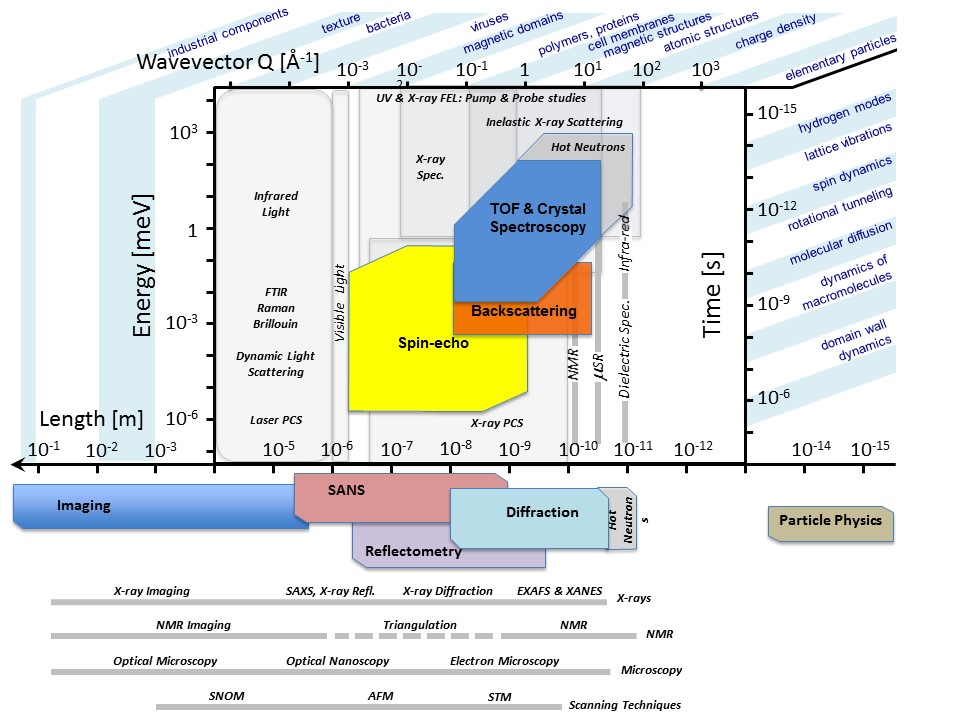Information for new users
What can neutrons do for your science?
The neutron is a subatomic particle with no net electric charge and a mass slightly larger than that of a proton. It also forms part of the nucleus of an atom.
The unique properties of this particle can help solve all sorts of scientific questions, in particle and nuclear physics and by scattering neutrons from samples to learn about the structure and dynamics of condensed matter systems in physics, chemistry, biology, engineering, etc.
You'll find below general information on the neutron, on experimental techniques using neutrons, and how they can make impactful contributions to your science:
- about neutrons
- neutrons for : chemistry and materials, soft matter and biology, magnetism and quantum materials and nuclear and particle physics
- neutrons for : energy, environment, health and quantum materials
What the ILL offers
Neutron techniques
Neutron techniques
This figure shows the time and length (energy and wavevector) scales of the various neutron-based techniques (Courtesy: Ken Andersen). You can use it to identify the techniques which will best match your needs and then consult the list below to choose the appropriate instruments.
Neutron diffraction reveals structural information on the arrangement of atoms and magnetic moments in condensed matter.
Small Angle Neutron Scattering (SANS)explores the mesostructures of liquids and solids on length scales ranging from 1 nanometre to about a micron.
gives information (depth-dependent composition) on the structure of thin films and surfaces which can be solid/solid, solid/liquid, liquid/liquid and liquid/air interfaces.
Neutron spectroscopy (TOF, TAS, Spin-echo, Backscattering) probes the dynamics of magnetic moments, molecules and lattices over length scales ranging from a few angstroms to tens of nanometers, and over timescales from tens of picoseconds up to the microsecond.
Neutron imaging is a non-destructive technique, highly complementary to X-ray imaging, that can see inside materials and examine processes therein.
 (pdf - 207 Ki)
(pdf - 207 Ki)Click to enlarge
How do I access ILL's instruments?
Beam time at the ILL can be obtained in different ways, but is typically arranged via the standard submission of a scientific proposal to be evaluated by a scientific panel. Proposal rounds are generally held twice a year, with submission deadlines in February and September. For a successful application it is important to define clearly the scientific case and the proposed experiments. At this stage, especially if it is your first proposal, you need to identify the neutron technique, instruments, sample environment and scientists, whose assistance you will need for your research.
You will find here a list of ILL instruments. Scientific contact information is available directly on the webpage of each instrument.
Access to the ILL instruments is free for academic and industrial users, as long as you comply with the ILL data and publication policy (pdf - 42 Ki). ILL users enjoy privileged access to highly-specialised neutron instrumentation and the expertise of its scientific and technical staff. Industrial access to beam time can also be fully confidential and fast-tracked. For information on conditions, please contact the Industrial Liaison Office.
Standard proposals submission deadlines
Proposals can be submitted all year, with deadlines in February and September.
Next proposal deadline will be on Monday 16 February 2026 (midnight, CET).
Submit your proposal via the User Club. Check for more detailed information.
The proposals evaluation will take place on 15-15 April 2026. Final results will be communicated to all proposers after the national balance adjustment, from 4 May.
Scientific excellence is the primary evaluation criterion. However, providing complete and detailed information at the time of submission is highly beneficial, as additional factors—such as industrial relevance, the presence or absence of experimental reports, the proposer’s publication track record, or links to PhD projects—may also influence the assessment either positively or negatively.
Contact the experts! We strongly recommend to engage with facility staff or experienced users to refine the proposal and increase its strength.
